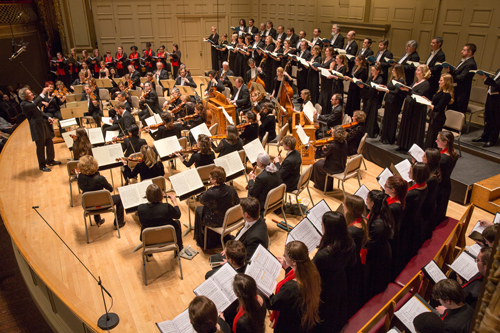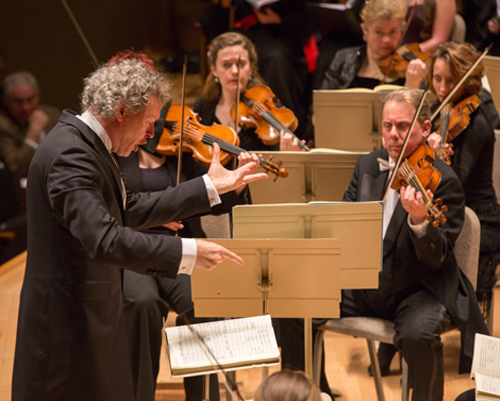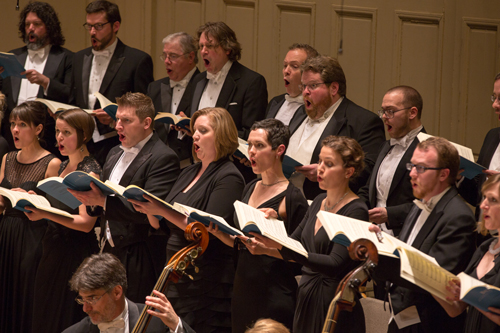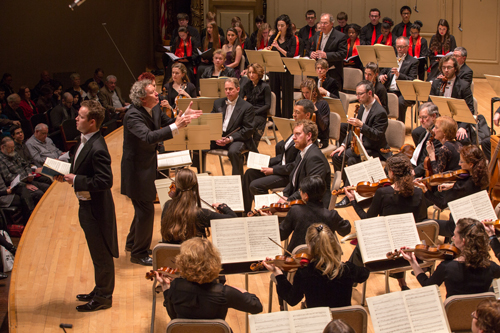by Daniel Hathaway

I joined a group of fellow members of the Music Critics Association of North America in Boston last weekend to learn more about the history of Handel and Haydn, and we all attended the Passion concert on Friday evening, March 27.
The original association of some 44 members who paid the modern equivalent of $750 to join up managed to organize a chorus of 100 (90 men and ten women) to sing that first Christmas Day concert in King’s Chapel, accompanied by organ and a small instrumental ensemble. It went on for some time, apparently, with selections from Haydn’s Creation and excerpts from Handel’s Messiah, along with patriotic songs of the day. The Hallelujah chorus was saved for the finale.
Twenty decades later, after a series of shifts in direction, H+H has become a chorus of 30-some professional singers with an accomplished period-instrument orchestra, and a number of educational and community initiatives that compliment its eleven-concert season in Jordan Hall, Faneuil Hall and Symphony Hall (where H+H has performed since the building was opened in 1900). Harry Christophers, founder of the British vocal ensemble, The Sixteen, was named artistic director in 2009, succeeding Sir Roger Norrington.
For the Matthew-Passion performance on March 27 (the work was repeated on Sunday afternoon, March 29), Christophers assembled a chorus of 34 singers (seventeen in each choir), a group of 40 young singers from H+H’s Vocal Arts program to take the parts of Bach’s boychoir, and two orchestras, each with nine violins, two violas, two cellos, bass, two flutes, two oboes, bassoon and organ. The stage was already full of musicians when Christophers and the six soloists entered from the wings.
Making full use of what historical performance research has revealed about singing and playing music in Bach’s time, Christophers led a brisk yet highly expressive performance that clocked in at precisely three hours, including intermission.
That briskness began with the opening chorus, a light pulsing dance soon complicated but not weighed down by the entrance of the two choruses and the overlay of the chorale, “O Lamm Gottes unschuldig,” sung by the young choristers. H+H’s fine sense of ensemble and precision was evident during the first few bars of music and never flagged through the rest of the lengthy Passion story. It revealed itself over and over again in such difficult-to-coordinate movements as “O Mensch, bewein” and in the crowd scenes that later intensify the drama.
Christophers paced the narrative splendidly, linking movements into a chain of dramatic arcs that moved the story along and only occasionally felt a bit hurried. He had a wonderful ally in Joshua Ellicott, who sang the Evangelist, varying his delivery as the script required, sometimes almost shouting at key moments, sometimes singing sotto voce when the affect demanded it. Ellicott was a master of pace as well: recitativo passages that can seem endless breezed along in this performance.
The chorus achieved an excellent blend, singing with focus, gusto and fine diction but without the affected inflections and phrasing that plague many “early music” performances. Christophers made special moments out of the chorales, calling for an entire range of emotions which the whole choral contingent was happy to supply. Chorus members also ably supplied a number of minor solo roles in the drama.
Soloists, often a mixed bag in Bach passion performances, were uniformly superb. Baritone Roderick Williams crafted a Jesus who was noble yet human in scale. Soprano Joélle Harvey’s “Aus Liebe will mein Heiland sterben,” weightlessly supported by flute and two oboi da caccia (Christopher Kreuger, Stephen Hammer and Lani Spahr), was completely affecting. Though she might have taken a bit more opportunity to emote in “Erbarme dich,” mezzo-soprano Anna Stéphany sang that famous aria with a welcome freshness, ably assisted by concertmaster Aisslin Nosky, who deftly projected all the tiny inner notes in her ornate violin line into the big space of Symphony Hall.
To name only a few other solo items, tenor Matthew Long (above) made something truly touching out of “Geduld,” the strange aria that follows the incident of the false witnesses. Baritone Sumner Thompson was solid and strong in that other strange aria, “Gebt mir meinen Jesu wieder,” a mini violin concerto whose brisk tempo was bravely and effectively handled by Christina Day Martinson, who headed up the second orchestra.
There were other highlights too many to mention, but for sheer, ground-shaking drama, the whole company’s depiction of the gates of hell opening up in “Sind Blitzen, sind Donner” was amazing. Its tutti cry of “Barabbas!” was terrifying in its three-note intensity.
Three hours flew by, and suddenly we had arrived at the tender moment when four soloists in turn bid everyone to sing “Gute Nacht” to Jesus. Conceiving “Wir setzen uns,” the final weeping of mourners at the tomb, as a keening chorus of grief rather than as a sacred lullaby, Harry Christophers brought a memorable Matthew-Passion to a dramatic conclusion.
Photos by James Doyle.
Published on ClevelandClassical.com March 31, 2015.
Click here for a printable copy of this article






